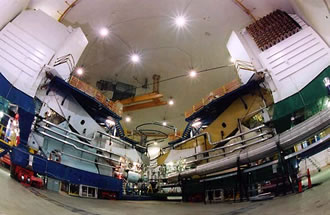Medium Energy Physics
The goals of the Medium Energy Physics group in the Physics Division of Argonne National Laboratory are to test our understanding of the structure of hadrons and the structure of nuclei, and to develop and exploit new technologies for high-impact applications in nuclear physics, tests of fundamental symmetries and other national priorities. The major thrusts of the program are:
The Hermes Experiment at DESY.
HERMES measures the interaction of polarized 25-30 GeV positrons with polarized internal targets of hydrogen, deuterium and Helium-3. The measurements focus on the deep inelastic spin structure functions of the nucleon. In 2002, the transverse polarized hydrogen target was installed. One of the goals is to provide the first measurement of the transversity structure function of the proton, The polarization of the quark sea will be measured using asymmetries of events with charged hadrons detected in coincidence with the scattered positrons. A list of HERMES publications is available on SPIRES.
JLAB Experiments.
 At Jefferson Lab (JLab) we are focusing on the structure of the hadrons, exotic features of nuclei, as well as the study of the Standard Model. In particular, we are involved in a variety of experiments at JLab, including measurements of elastic form factors of the pion and the proton, the search for exotic states of matter in nuclei, high energy photoreactions, the effect of color transparency in rho production, and tests of the Standard Model. These experiments are or will be performed in Hall A, Hall B and Hall C.
At Jefferson Lab (JLab) we are focusing on the structure of the hadrons, exotic features of nuclei, as well as the study of the Standard Model. In particular, we are involved in a variety of experiments at JLab, including measurements of elastic form factors of the pion and the proton, the search for exotic states of matter in nuclei, high energy photoreactions, the effect of color transparency in rho production, and tests of the Standard Model. These experiments are or will be performed in Hall A, Hall B and Hall C.
Completed experiments include measurements of (e,e'p), (e,e'pi), and (e,e'K) reactions and a series of cross section and polarization measurements of real photon reactions (gamma+d-->p+n and gamma+N-->pi+N). We have recently completed data taking for a proton form factor measurement, and for a search for color transparency. We are currently leading the program of testing the Standard Model via parity violation in deep inelastic scattering (PV-DIS) using both the currently available 6 GeV beam (E05-007) and at the future 12 GeV upgrade of JLab. The experiment E05-007 was approved in January 2005 and is expected to take data in 2008.
Trapping and Probing Atoms of Rare Isotopes with Laser Light.
We are developing new methods and improvements to existing techniques for controlling atoms of rare isotopes, which we are using to study new problems in nuclear physics and to develop novel applications based on Atom Trap Trace Analysis (ATTA).
Tests of Fundamental Symmetries.
The optical trapping method is being applied to test the time reversal symmetry, and thereby search for new physics beyond the standard model. Other Standard Model tests we are currently pursuing include the PV-DIS program at Jefferson Lab.
Drell-Yan Measurements of Proton Structure
 We are conducting a series of fixed target Drell-Yan experiments designed to measure the quark and antiquark structure of the nucleon and the modifications to that structure which occur when the nucleon is embedded in a nucleus. With these measurements, we are also able to quantify the energy loss of a colored parton (quark) travelling through cold, strongly-interacting matter.
We are conducting a series of fixed target Drell-Yan experiments designed to measure the quark and antiquark structure of the nucleon and the modifications to that structure which occur when the nucleon is embedded in a nucleus. With these measurements, we are also able to quantify the energy loss of a colored parton (quark) travelling through cold, strongly-interacting matter.
The first of these expeirments, E866/NuSea took place at Fermilab. The primary focus of this experiment was to measured the asymmetry of down and up antiquarks in the nucleon sea using Drell-Yan di-muons produced in 800 GeV proton interactions with hydrogen and deuterium targets. It has also made measurements of the suppression of the production of J/Psi's in nuclei over a broad range in xF and pT as well as angular distributions for Drell-Yan, J/Psi and Upsilon production.
To extend these measurements to larger Bjorken-x, E906/Drell-yan has been approved by Fermilab. It will use a 120 GeV proton beam extracted from the Fermilab Main Injector. In addition to extending the down to up antiquark measurements, the experiment will also examine the modifications to the antiquark structure of the proton from nuclear binding. This experiment currently being assembeled at Fermilab. It is expected to be comissioned in 2010 and collect data for two years.
Following the completion of E906/Drell-Yan, we are exploring possibilities of continuing the Drell-Yan scattering program using the 50 GeV proton ring at the J-PARC Nuclear and Particle Physics Facility.
![[Argonne Logo]](https://webarchive.library.unt.edu/eot2008/20080916064300im_/http://www.phy.anl.gov/images/argonne_header_logo.jpg)




